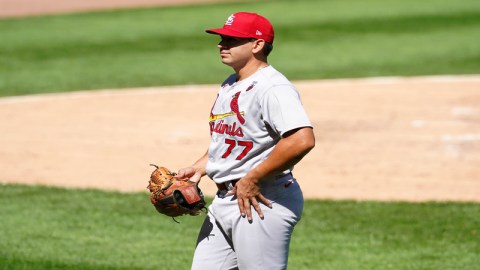Given that Paul the Octopus has picked Spain to win the World Cup finals tomorrow, actually analyzing the match-up is pretty much an exercise in futility.
The German sea creature has never failed us. You’d be a fool to think he would start now.
But if you’re interested in knowing a little bit more about what to watch for tomorrow, then go ahead and join me for a breakdown of the two squads, the two greatest teams yet to be called World Champions. Otherwise, all you need to know will unfold in the drama below:
Thrilling.
Now, back to the breakdown…
Striker: Spain’s David Villa and Holland’s Robin Van Persie
Van Persie is a world class striker, one of the most technically gifted finishers in the world in the prime of his career. David Villa, though, is the best in the world. It’s hard to figure out exactly what makes Villa so good. Generally positioning himself on the left side of the field, Villa just has a knack for putting himself in the right place at the right time and making the most of the opportunities given to him. He has already scored five goals thus far in South Africa. The rest of the team has only scored two.
Advantage: Red
Free Kicks: Spain’s Xavi and Holland’s Wesley Sneijder
Many minds in soccer will tell you that with David Beckham‘s receding from the international spotlight, the torch as world’s best free kick taker has been passed to Xavi. The Barcelona star, though, has struggled to control the Jabulani and has looked out of sorts for much of the tournament. Sneijder, the best player on European Champions Inter Milan, has been at the top of his game in South Africa, matching Villa’s five goals as a midfielder. His play has earned him a 25 million pound bid from Manchester United, and that may be a bargain for a talent who has proven that he is one of the world’s best.
Advantage: Orange
Dribbling Virtuoso: Spain’s Andres Iniesta and Holland’s Arjen Robben
There are four soccer players in the world who are, by a large margin, more skilled on the ball than any others. Two of them, of course, are the world-famous Lionel Messi and Cristiano Ronaldo. The other two are Iniesta and Robben. Iniesta may be Spain’s most inventive and important player, using his vision, touch and creativity to nearly magically forge scoring opportunities out of nothing. Still, while he showed flashes of his usual brilliance against Germany, the diminutive midfielder has not been at top form in the tournament. While Iniesta generally plays down the center of the field or down the left, Robben can always be found on the right wing. Generally considered to have the most dangerous left foot on the planet, the Dutch will continually look to feed the winger the ball down the right side, hoping that he can beat the Spanish defenders off of the dribble before crossing the ball in or shooting with his deadly left side. In the quarterfinals and semifinals, the Bayern Munich star performed admirably, drawing a red card from Brazil’s Felipe Melo and scoring a difficult header that proved to be the winner against Uruguay. Both players suffered from injuries prior to the World Cup, but Robben has looked the better player so far.
Advantage: Orange
Goalkeeper: Spain’s Iker Casillas and Holland’s Maarten Stekelenburg
While Stekelenburg likely made the save of the tournament, diving full-stretch to bat away a Kaka strike that would have given Brazil a 2-0 lead against the Dutch in the quarterfinals, he simply is no “Saint Iker.” Casillas, is arguably the best keeper in the world and has proven such time and time again in South Africa. How many goals has Spain conceded at the World Cup? A mere two — none since the knockout round began. Casillas has saved penalty kicks, breakaways, long range strikes … pretty much everything. No matter who Holland had in net, Spain would have the advantage.
Advantage: Red
Glue Guy: Spain’s Xabi Alonso and Holland’s Dirk Kuyt
Despite employing very different styles, Kuyt and Alonso surely have in common that they are their team’s respective unsung heroes. Alonso is unquestionably Spain’s deadliest long range shooter, and balls have a way of falling to his feet about 20 yards from net. The Spanish may not draw up the plays for Alonso, but he still manages a multitude of scoring chances over the course of most matches. Still, he has yet to master the Jabulani, hitting the frame repeatedly throughout the tournament. Kuyt — playing on the wing opposite of Robben — often goes under the radar, but he is without a doubt Holland’s scrappiest and hardest-working player. Even though he is a left wing, you can generally find him wherever the ball is, and like Villa, he has a knack for being in the right place at the right time.
Advantage: Orange
Defensive Leader: Spain’s Carlos Puyol and Holland’s Giovanni van Bronckhorst
The emotional leaders of their teams, both Puyol and van Bronckhorst provided magic in the semifinals, scoring amazing goals at the most unexpected of moments. Van Bronckhorst’s 40-yarder may have been the shot of the tournament:
Still, the Dutch captain’s best years are likely behind him, and he is not only retiring from international soccer after the tournament, but retiring from soccer all together. Clearly, this run means as much to him as it possibly could, but he simply isn’t the player that Puyol is.
Advantage: Red
Other Defenders: Spain’s Gerard Pique, Sergio Ramos, and Joan Capdevilla and Holland’s Gregory van der Weil, Johnny Heitinga, and Joris Mathijsen
If the Dutch have a weakness, it is perhaps that their defenders, particularly central defenders, do not match the star level of their attacking players. They counteract this by playing two defensive midfielders in Nigel de Jong and Mark Van Bommel, but if behind, one of those two will be replaced by the more attack-minded Rafael van der Vaart. If that occurs, the Dutch defenders will have to fend for themselves. Brazil was able to exploit their weakness to score an easy goal against Holland early in their quarterfinal match, and Spain offers perhaps even more attacking potency. Maarten Stekelenburg will have to do well to keep his back line organized and on top of play. Spain’s defenders, all world class talents, have compiled an unbelievable record in South Africa, but perhaps that can be attributed more to the ability of the Spanish midfield to possess the ball than to the work of their defense. Spain’s defenders like to press forward on the attack, which could prove costly against a team as precise and speedy as Holland. While it is unlikely that Spain will shut out the Dutch, they are the better defensive team.
Advantage: Red
Bench:
While van der Vaart, young winger Eljero Elia, and hulking stiker Klaas-Jan “The Hunter” Huntelaar are all great weapons to have, Spain leaves one of the world’s best players, Cesc Fabregas, on the bench. Fernando Torres — another of the world’s elite — also may not start, and that is just the beginning of the list.
Advantage: Red
Current Form:
Many people have claimed that Holland has “won ugly,” beating Brazil and Uruguay with deflected goals, and nervously hanging on to wins in both matches, but Holland’s record is perfect in South Africa. Spain, recovering well from their opening loss to Switzerland, has still never fired on all cylinders, winning each of their knockout matches 1-0. Spain may be the slightly more talented and highly ranked team (FIFA No. 2 versus FIFA No. 4), but Holland has been the strongest team in South Africa, arguments from Germany aside.
Advantage: Orange
Chemistry:
While Spain has by far the most talent of any team in the world, they have looked much less than the sum of their parts and have been visibly frustrated. There seems to be a nervousness about the Spanish, as though they have been waiting to blame their coach for their impending failure, and their victories have appeared joyless. Spain’s fans, for some reason, clearly appear to expect disappointment.
While heartbreak in World Cups has almost become a cornerstone of Dutch society, you’d never know it by how much fun Dutch Masters look to be having. Celebrating goals with head first slides, full-team piles, and goofy smiles into the camera, there is a joy about the Dutch that has made them great entertainment in South Africa. Their fans, it must be said, have added to this, proving to be the World Cup’s best partyers, with the royal family even joining in. After their semifinal win, the Dutch squad came back out onto the field and joined in with their countrymen thirty minutes after the match had ended. On the field, their chemistry looks much the same, maximizing their talent and relying on precise communication.
Advantage: Orange
So who wins? It’s not because of Paul, but Spain made a German team playing with great chemistry, joyand talent look scared, defensive and mediocre. Holland may be a more experienced version of that German squad, but I expect the same result.
Spain 2, Holland 1 A.E.T.
Who wins the World Cup?online survey



